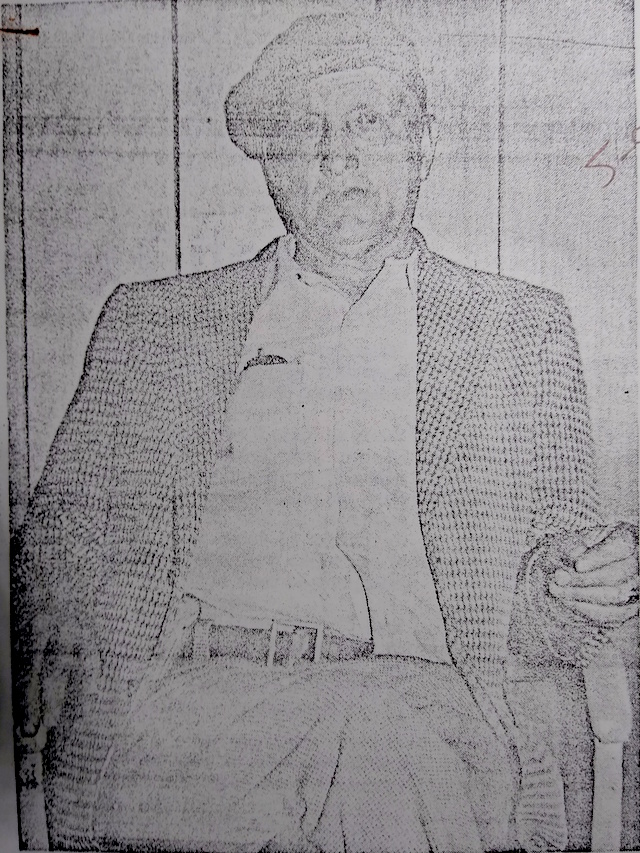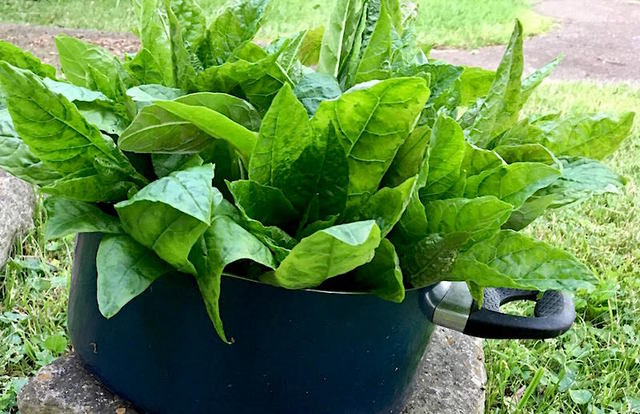| ||||||||||
Dr. Ronald P. Rogers CHIROPRACTOR Support for your body's natural healing capabilities 270-384-5554 Click here for details 


Columbia Gas Dept. GAS LEAK or GAS SMELL Contact Numbers 24 hrs/ 365 days 270-384-2006 or 9-1-1 Call before you dig Visit ColumbiaMagazine's Directory of Churches Addresses, times, phone numbers and more for churches in Adair County Find Great Stuff in ColumbiaMagazine's Classified Ads Antiques, Help Wanted, Autos, Real Estate, Legal Notices, More... 

|
May 5, 1978 Around Adair with Ed Waggener The article below was first published on May 5, 1978. It didn't actually run as an Around Adair then, but we're designating it one for the digital age, for the very scientific reason that a photocopied version was preserved in a box of Around Adair articles, and it seems to fit. Plus, the Depression-era recipes may prove handy in 2020. In addition to the great write-up on Mr. Giles, there's a recounting of a meal in Spout Springs with cousin Henry and Janice. --Pen By Ed Waggener Poke picking proves profitable for Johnny Giles Johnny Giles loves to pick poke. From early May to the end of the month, Giles hits the poke patches and picks it by the bushel. In the four week period, he will pick about $600 worth of the stuff, some 150 bushels at $4 per bushel on the Cincinnati produce market. He sells the stuff in three trips to the Queen City. They know Johnny Giles up there and they know he picks good poke. You can sell anything Johnny Giles lives in the Knifley area. He's semi-retired from the fruit peddling business, but he has never got produce selling out of his blood. Not too many years ago, neighborhood kids often picked poke and aggravated neighborhood women who bought the greens just to humor the kids. Nobody dreamed that poke would actually have a commercial value. But today, with lettuce going to $1.19 a head, nearly any edible thing can be sold. And Johnny Giles knows it. "You can market anything you can raise," Giles says. "Why I remember how one year I paid a neighbor $1.50 per bushel for turnips and brought them to town and sold them at three pounds for $1--that's about $20 per bushel--and people were glad to get them." Picks his patches Giles says that he can pick as much as one bushel in 15 minutes, but, he says, "You have to have good pickings. I've had fellows tell m e about patches with 'a world of poke' only to go there and find only three or four bushels." Around excavations are best, he says. "There's a lot of new ground where they doze and it seems like they push the poke roots over in a pile along the edge, and it grows real thick there." But it's hard work. "You have to contend with snakes and lizards and briars," Giles says, "It's really a tough job." But mostly, he says, the snakes he meets are usually harmless black snakes. It's a commercial crop down South Giles says that poke is a commercial crop in the South. "They grow early poke in Georgia and I hear they get $7-8 per bushel for it." He thinks that it could be grown in Adair County, too, but he himself isn't interested. The May volunteer crop is the one he's interested in, and he says that while poke could be picked all summer long, he'd rather go to peddling fruit after he completes the May harvest. "Besides," Giles says, "I hear that the cultivated poke isn't as good." But with a sly grin, he admits, "I gotta say that, being in the natural poke business." He eats it, too Giles gets almost angry if he's asked if he eats poke. "Of course I do! We eat it as greens every chance we get. But we do mix it with mustard greens. We like it mixed better." He says that his family likes raw poke in salads. "I wouldn't want to eat it alone, though, it's better mixed in other greens." Poke is an inexpensive substitute for salmon, Giles says. "Back in the Depression we used to mash up poke and mix it with cornmeal and cook it like salmon croquettes. That's what we called them. And they tasted a lot like salmon, as I remember. Salmon were cheap then--about 10 cents a can--but we couldn't afford even that often." His wife, he says, eats the pokeberries in the fall. "She says that it helps her arthritis. I believe it does." The root of the poke plant has medicinal uses, too. "Oldtimers used to use the poke root to treat itch. It worked. The old folks knew those things," Giles says. Kin to Henry Johnny Giles is an own-cousin of the "Spouts Springs Lizard," Henry Giles, another connoisseur of poke. (Janice Holt Giles, Henry's wife, has a special way of fixing poke. She mixes it with mustard greens, and serves it with sour cream. It makes quite a dish. I remember eating once with the Gileses and poke was on the menu. It was served with some bream Henry caught in the lake and slaw and a special cornbread which had bacon strips in the bottom of the crust. Washed down with iced tea, it was one of the most royal feasts I can ever remember.) Like Henry, Johnny is a great story teller. He likes to relate the story of a poor family during the Depression who came to Columbia to see the doctor. They were obviously malnourished. "The doctor asked them what they had been eating," Giles says, "and they told him poke. The doctor asked them what they cooked the poke with and they told him they threw in a rabbit. The doctor was alarmed. 'No wonder you're sick, cooking your poke with an old winter-starved rabbit! It hasn't got any grease to kill the poison!'" In those days, Giles says, people believed that it took a lot of grease to kill the poison in the poke. Even so, he says, the old folks thought they didn't have their systems cleaned out for warm weather unless they had a mess of poke sallet. Giles has a method Giles has a special method for cutting his poke. "I cut for a day or two," he says, "and when I take the load to Spout Springs and let spring water run over it while I'm picking more and until I get ready to take it to Cincinnati. That way the poke says even crisper than when I pick it in the fields. Then when I get to Cincinnati I get some ice and put it on the poke. That keeps it fresh." They know Giles sells good poke. "I had one fellow try to tell me my poke wasn't good one time," he recalls. "I looked him in the eye and told him, 'I've picked more poke, ate more poke, and sold more poke than you've ever seen.' That shut him up. He bought it and was glad to get it." Giles carries a giant Case knife to cut his poke. "I could break it off, but it doesn't look as good in the produce case, so I make a nice cut with my knife." He was asked by writer Mike Murrell if he also used the knife to fend off snakes. "No, my knife's not good for that--that's what these feet are for," he said. Restaurants would be market Giles believes that restaurants would be a good market for his poke, but he doesn't have time to peddle it and take care of the wholesale market. He wouldn't do it, but he would encourage others to go into the business. He himself is happy just making a living with his Social Security, poke picking money, and income from apple peddling. He's a remarkable man. This story was posted on 2020-05-03 11:18:34
Printable: this page is now automatically formatted for printing.
Have comments or corrections for this story? Use our contact form and let us know.
More articles from topic Around Adair with Ed Waggener:
January 18, 1978 Around Adair with Ed Waggener February 9, 1978 Around Adair with Ed Waggener May 1978 Around Adair by Ed Waggener April 29, 1978 Around Adair with Ed Waggener February 2, 1978 Around Adair with Ed Waggener March 14, 1978 Around Adair with Ed Waggener April 18, 1978 Around Adair with Ed Waggener March 7, 1978 Around Adair with Ed Waggener March 2, 1978 Around Adair with Ed Waggener February 8, 1978 Around Adair with Ed Waggener View even more articles in topic Around Adair with Ed Waggener |


|
||||||||
|
| ||||||||||
|
Quick Links to Popular Features
Looking for a story or picture? Try our Photo Archive or our Stories Archive for all the information that's appeared on ColumbiaMagazine.com. | ||||||||||
|
Contact us: Columbia Magazine and columbiamagazine.com are published by Linda Waggener and Pen Waggener, PO Box 906, Columbia, KY 42728. Please use our contact page, or send questions about technical issues with this site to webmaster@columbiamagazine.com. All logos and trademarks used on this site are property of their respective owners. All comments remain the property and responsibility of their posters, all articles and photos remain the property of their creators, and all the rest is copyright 1995-Present by Columbia Magazine. Privacy policy: use of this site requires no sharing of information. Voluntarily shared information may be published and made available to the public on this site and/or stored electronically. Anonymous submissions will be subject to additional verification. Cookies are not required to use our site. However, if you have cookies enabled in your web browser, some of our advertisers may use cookies for interest-based advertising across multiple domains. For more information about third-party advertising, visit the NAI web privacy site.
| ||||||||||






















































